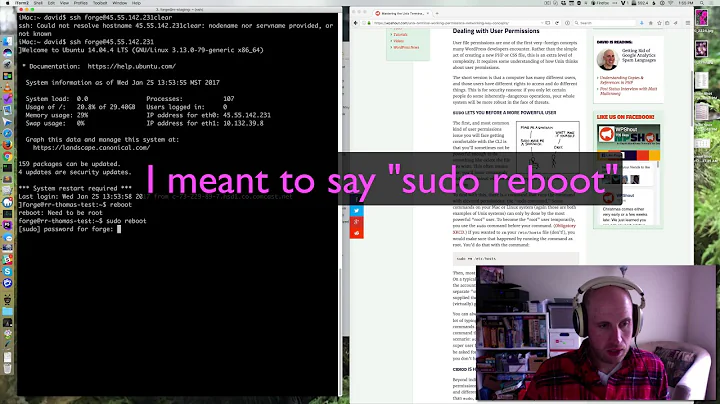Closing connection after executing reboot using ssh command
Solution 1
The command reboot -f never returns (unless you didn't have permission to cause a reboot). At the point where it is issued, the SSH client is waiting for something to do, which could be:
- the SSH server notifying the client that something happened that requires its attention, for example that there is some output to display, or that the remote command has finished;
- some event on the client side, such as a signal to relay;
- a timer firing up to cause the client to send a keepalive message (and close the connection if the server doesn't reply).
Since the SSH server process is dead, the SSH client won't die until the timer fires up.
If you run ssh remotehost 'reboot -f >/dev/null &', then what happens is:
- The remote shell launches the
rebootcommand in the background. - Because the server-side shell command has exited and there is no process holding the file descriptor for standard output open, the SSH server closes the connection.
- The
rebootcommand causes the machine to reboot.
However, this is not reliable: depending on timing, step 3 might happen before step 2. Adding a timer makes this unlikely:
ssh remotehost '{ sleep 1; reboot -f; } >/dev/null &'
To be absolutely sure that the server side is committed to running reboot, while making sure that it doesn't actually reboot before notifying the client that it is committed, you need an additional notification to go from the server to the client. This can be output through the SSH connection, but it gets complicated.
Solution 2
I found this solution to perform the best for me.
Use -o "ServerAliveInterval 2" with your ssh command, like so:
$ ssh -o "ServerAliveInterval 2" root@remotehost reboot
The said option makes the client side poke the server over a secure channel every 2 seconds. Eventually as the rebooting proceeds, it will stop to respond and the client will tear the connection down.
Solution 3
Some answers were close, but the right answer is:
ssh [email protected] "nohup sudo reboot &>/dev/null & exit"
explanation:
- you want to
exitas the last command so the status of the last command is 0 (success). You can prepend a sleep if you wish, but it is not necessary - you need to run reboot in the background, because otherwise the server will close the connection and you will get an error. It will still reboot on most systems but if you are scripting the return status will be error (not 0) even with the command executing properly
- running on the background is not enough, as the
stdinandstdoutare still attached to the virtual terminal through SSH, so the connection will not be closed. You need to do two extra things for the SSH session to end and leave the command running on the background.- 1) you need to redirect
stdoutandstderrto/dev/nullso they are not redirected by the virtual terminal that holds the SSH session. This is the&>/dev/nullpart. - 2) you need to redirect
stdinto an unreadable file in the same fashion. That is what the shell builtinnohupdoes.
- 1) you need to redirect
With only a command running on the background dettached from the terminal in every way, exit will close the session and because there are no stdin or stdout left on the virtual terminal SSH will terminate the connection without errors.
Solution 4
I use the following command:
ssh -t <hostname> 'sudo shutdown --reboot 0 && exit'
Here is what this is doing:
- It instructs the machine to reboot in the next moment, but not during this command
- Exits cleanly from SSH
- Maintains the SSH TTY the entire time so sudo is happy and can execute properly.
Related videos on Youtube
Comments
-
tuzion almost 2 years
I am using the
reboot -fcommand remotely to force reboot a Unix machine. The problem is that the ssh connection remains active for a long time which I don't know why? I want to close the ssh connection immediately after rebooting the machine and return to my local shell. How can i do that? Note that the reboot command without-fflag does not work.-
gertvdijk over 11 yearsWhy not just exit your remote connection (Ctrl+D) and let the server reboot without you having to watch the shell prompt?
-
tuzion over 11 yearsI found a solution for this which might be helpful for others as well. I used the following command to close the connection right after starting the command attached to ssh: ssh host "command to run on the host machine > /dev/null &" I don't fully understand the reason why this command forces the connection to close done but at least it was helpful for me. If anyone understands the directing of the output of the command to /dev/null and why it kills the ssh connection it would be nice if he/she can explain it. :-)
-
tuzion over 11 yearsssh host "command to run on the host machine > /dev/null &"
-
Tom over 5 yearsIt's not an answer to this question, but it's useful to know anyway: The SSH client has a series of control characters that can be used, among other things, to kill the client. Control characters are only recognized immediately after a newline, so start by pressing
Enter. Then eg~.to terminate the session.Enter ~?for a list of others.
-
-
tuzion over 11 yearsUnfortunately this doesn't work.
-
gertvdijk over 11 years@AKh_Sw Be specific to "doesn't work".
-
tuzion over 11 yearsYes, shutdown doesnot work in the machine which i am trying to connect to for some strange reasons. That is why i use reboot -f to force a shutdown and restart.
-
Sharif Chowdhury over 11 years@AKh_Sw : if you typed the '$' sign it won't work
-
 Gilles 'SO- stop being evil' over 11 yearsUseless. This is exactly equivalent to
Gilles 'SO- stop being evil' over 11 yearsUseless. This is exactly equivalent toreboot -f. -
Griddo over 7 yearsIn case anyone is looking for a way to do this from within the remote host (similar solution):
(sleep 1 && sudo reboot &) && exit. The parentheses spawn a subprocess, which waits one second and then initiates the reboot. The host process however immediately terminates the ssh session. I'm not a shell guru, but this worked for me so far. -
MikeW about 7 yearsOr substitute your system's equivalent to "shutdown -r now" for a reboot ....
-
Joshua Pinter over 5 years@Griddo That worked fantastic and is a neat little hack. I love it. Thanks for sharing!
-
 stdcerr almost 5 yearsThanks Roman, works like magic! :)
stdcerr almost 5 yearsThanks Roman, works like magic! :) -
 leandro minervino about 4 yearsCan you have two -o flag in a single call? I need to also run
leandro minervino about 4 yearsCan you have two -o flag in a single call? I need to also run-o StrictHostKeyChecking=no




